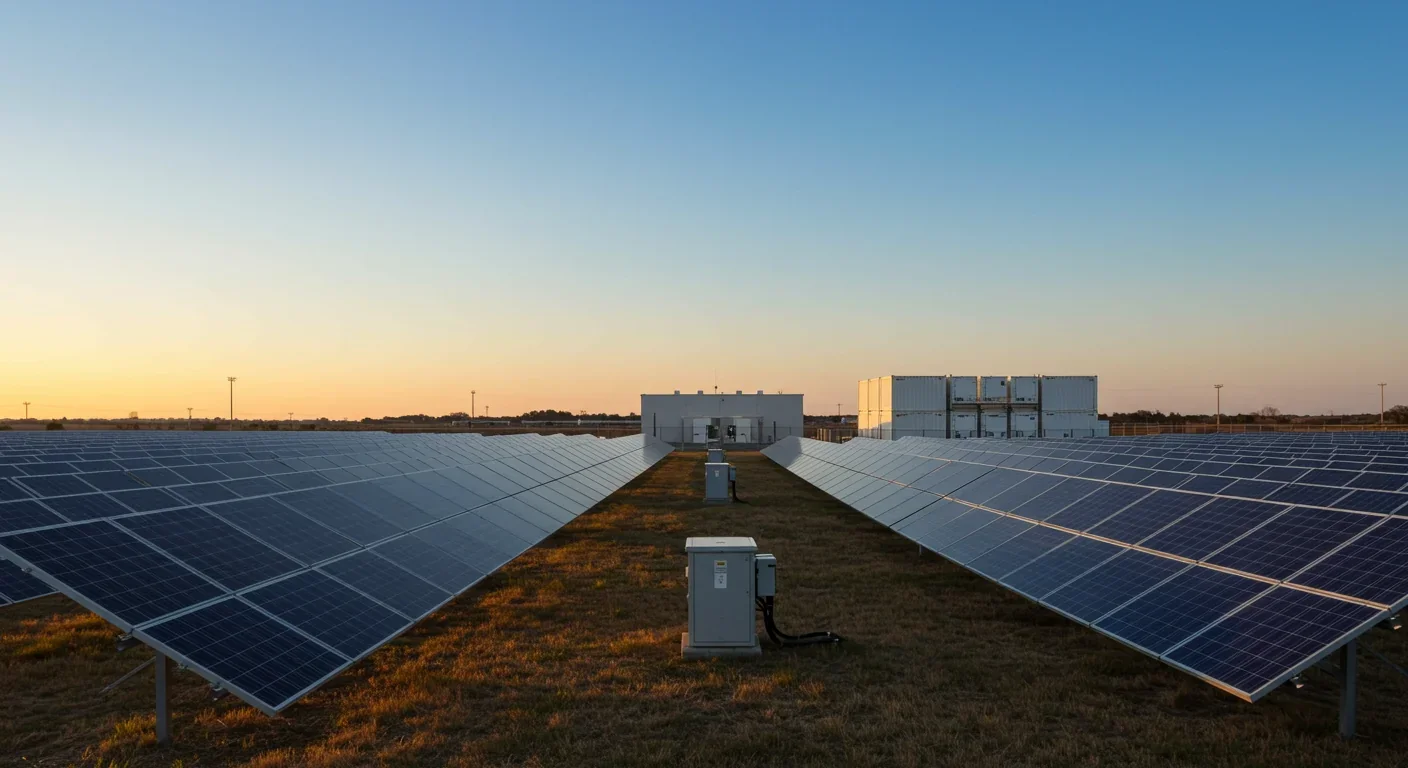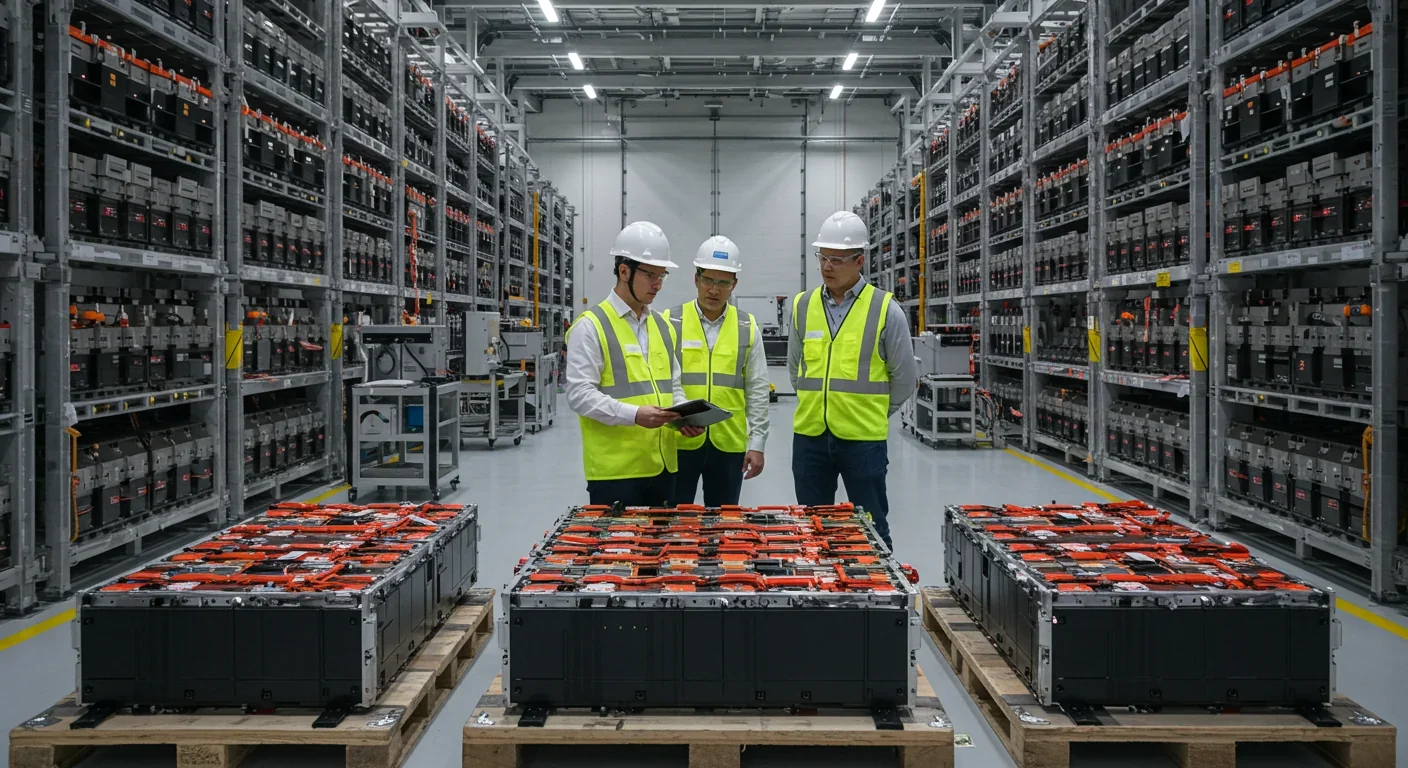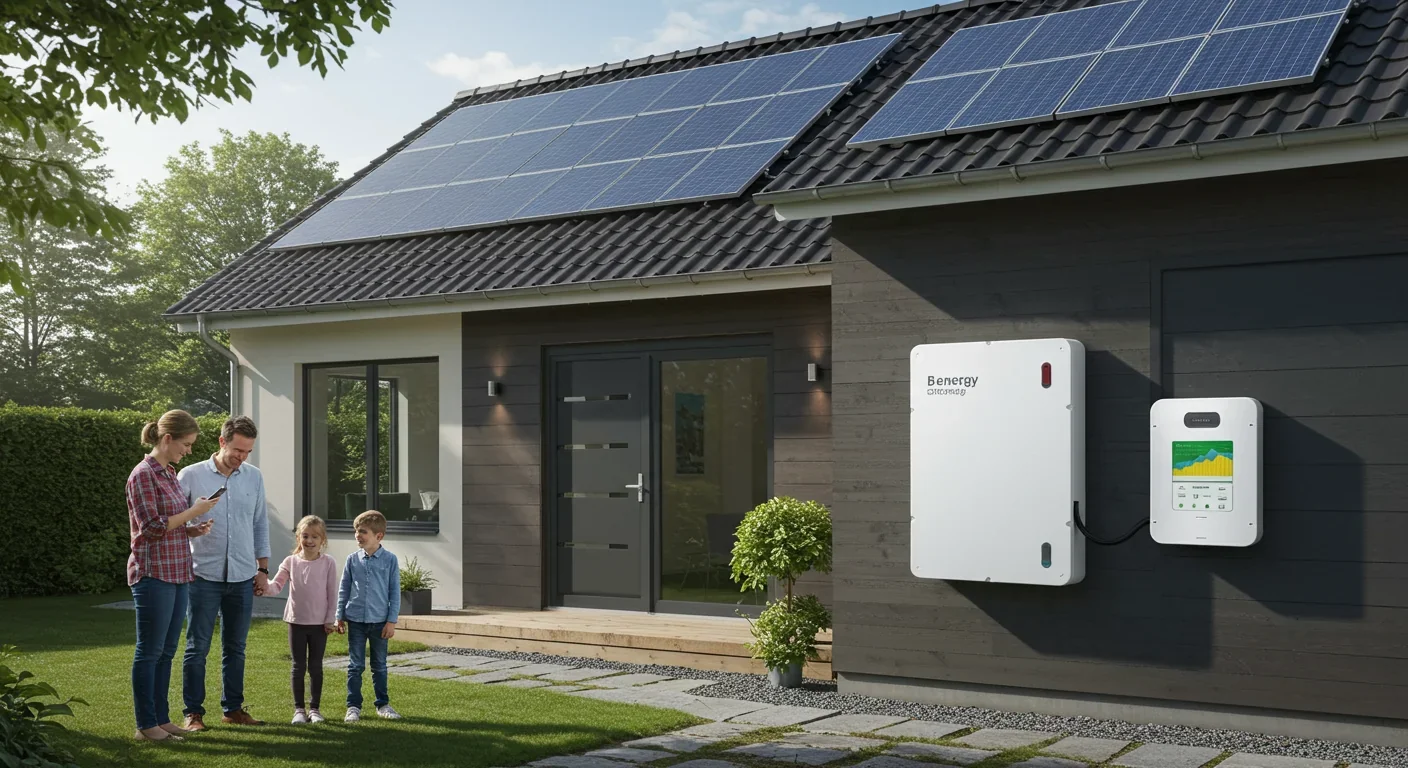Digital Pollution Tax: Can It Save Data Centers?

TL;DR: Energy storage systems are transforming renewable energy from intermittent to reliable by capturing excess solar and wind generation for later use. With battery costs down 80% since 2010 and global capacity set to triple by 2030, storage is making clean grids economically viable.

By 2030, the world will install three times more energy storage than it had by the end of 2023. That's not just growth—it's a fundamental rewiring of how civilization powers itself. While solar panels and wind turbines grab headlines, the silent partner making it all work is energy storage. Without it, renewables remain promising but unreliable. With it, they become the backbone of a decarbonized grid.
Here's the uncomfortable truth about renewable energy: the sun doesn't shine at night, and the wind doesn't blow on schedule. This isn't news to anyone in the energy sector, but what's changed is our ability to solve it. For decades, this intermittency problem limited how much renewable capacity grids could absorb. When wind generation spiked at 2 AM and nobody needed the power, utilities had to curtail output or risk destabilizing the grid.
Energy storage systems fundamentally change this equation. They capture excess generation during peak production hours and release it when demand outstrips supply. It sounds simple, but the technical and economic challenges of doing this at grid scale have been enormous. Until recently, that is.
In 2023, global installed energy storage capacity hit 230 gigawatts—enough to power tens of millions of homes during peak demand. More importantly, battery prices have plummeted more than 80% since 2010, crossing a critical threshold where storage becomes economically viable without heavy subsidies. This cost trajectory mirrors what happened with solar panels a decade earlier, and the implications are just as profound.
Energy storage isn't one technology but a portfolio, each with distinct strengths. Understanding which tool fits which job reveals why the storage revolution is accelerating so quickly.
Lithium-ion batteries dominate short-to-medium duration storage. The same chemistry powering your phone now anchors utility-scale installations like the 100 MW/200 MWh system deployed at China's CNNC Concentric Quanye facility in 2022. These batteries respond in milliseconds, making them ideal for frequency regulation—the constant micro-adjustments that keep grid voltage and frequency stable. Their cycle life now exceeds 10,000 charge-discharge cycles, meaning they can operate economically for 15-20 years.
Pumped hydro storage remains the workhorse for long-duration needs. By pumping water uphill when electricity is cheap and releasing it through turbines when prices spike, these systems store massive amounts of energy for hours or even days. China's Fujian-Zhouning project, commissioned in 2022 with 1,200 MW capacity, exemplifies the scale possible with mature technology. Pumped hydro accounts for over 90% of global energy storage capacity because it works, it's reliable, and it lasts 50+ years.
Flow batteries occupy a middle ground. They store energy in liquid electrolytes held in external tanks, allowing independent scaling of power (determined by stack size) and energy capacity (determined by tank volume). While less energy-dense than lithium-ion, flow batteries cycle over 1,000 times with minimal degradation, making them attractive for applications requiring daily deep discharges over decades.
Emerging technologies like solid-state batteries and hydrogen storage promise breakthroughs but face hurdles. Solid-state batteries could offer higher energy density and safety, but manufacturing at scale remains elusive. Hydrogen storage boasts impressive energy density, yet the round-trip efficiency—converting electricity to hydrogen and back—hovers around 40%, compared to 85-90% for batteries. As one comprehensive review notes, hydrogen "remains in the demonstration phase and requires more favorable economics and infrastructure investment to reach grid parity."

Cost trajectories tell the real story. When lithium-ion battery packs cost $1,200 per kilowatt-hour in 2010, grid-scale storage was a niche experiment. Today, with prices below $150/kWh and falling toward $100/kWh, the business case flips. Storage doesn't just enable renewables—it generates revenue through multiple value streams.
Consider frequency regulation. Grids require constant balancing between supply and demand, traditionally provided by natural gas "peaker" plants that ramp up quickly but run inefficiently. Battery systems respond faster, operate more precisely, and earn premium rates for this service. The Hornsdale Power Reserve in South Australia demonstrated this spectacularly, stabilizing a grid plagued by blackouts while earning back its $90 million investment in under three years through frequency services and energy arbitrage.
Energy arbitrage—buying low, selling high—becomes increasingly profitable as renewable penetration grows. When solar floods the grid at midday, prices drop or even go negative. Storage operators charge their systems during these troughs and discharge during evening peaks when prices spike. In markets with high renewable shares, this price volatility creates lucrative opportunities that help justify storage investments.
Capacity payments provide another revenue stream. Grid operators pay for guaranteed availability during peak demand periods, essentially purchasing insurance against supply shortfalls. Storage systems, which can respond within milliseconds, command premium capacity payments while avoiding the fuel costs and emissions of fossil peakers they replace.
This multi-value stacking transforms storage economics. A single battery installation might earn revenue from frequency regulation, energy arbitrage, capacity payments, and transmission deferral (delaying expensive grid upgrades by managing local constraints). Suddenly, projects achieve internal rates of return above 10%, attracting mainstream investors rather than just subsidy-seekers.
Integrating storage at scale requires rethinking grid operations. Utilities spent a century optimizing around predictable, controllable generation. Now they're learning to orchestrate a ballet of variable resources.
Advanced forecasting has become crucial. Machine learning models predict solar and wind output hours ahead with increasing accuracy, allowing operators to pre-position storage resources. When forecasts show an evening wind lull, storage systems charge earlier in the day to cover the anticipated gap. These predictive algorithms grow more sophisticated as they ingest years of operational data, turning intermittency from a liability into a manageable challenge.
Hybrid systems demonstrate the value of technology diversity. The Huaneng Luoyuan Power Plant in China couples a 20 MW supercapacitor bank with lithium batteries. Supercapacitors handle sub-second frequency fluctuations with nearly unlimited cycle life, while batteries manage hour-scale storage. This division of labor optimizes performance and extends system lifespan—each technology does what it does best.
Virtual power plants aggregate distributed storage into controllable resources. Instead of one massive battery, hundreds of smaller systems—behind commercial buildings, in community installations, even residential—act as a coordinated fleet. Software platforms manage these assets, bidding their collective capacity into wholesale markets. This approach reduces transmission constraints, improves resilience, and democratizes participation in energy markets.
Transmission deferral reveals storage's infrastructure value. When a growing neighborhood strains an existing substation, utilities traditionally build expensive upgrades. Now they're deploying strategically located batteries to manage peak loads, deferring or avoiding multi-million dollar transmission projects. The batteries earn returns while solving a capacity problem—a win-win that's reshaping utility planning.
Technology and economics create possibility; policy creates deployment. The acceleration in storage installations over the past five years owes as much to smart regulation as falling costs.
The United States' Investment Tax Credit, extended to standalone storage systems in 2022, provides a 30% upfront cost reduction. Previously, storage only qualified when paired with solar. This change unleashed project pipelines, allowing developers to site storage where it provides maximum grid value rather than wherever solar happens to be.
China's policy architecture drives its market dominance. The country's April 2024 Notice on Promoting Grid Connection and Dispatch of New Energy Storage mandates integration targets and streamlines permitting. Provincial governments offer additional incentives, and the national grid guarantees purchase agreements. Result: China accounts for over half of global storage installations.
The European Union's REPowerEU plan targets 200 GW of storage by 2030, framing it as essential to energy security after disruptions from the Ukraine conflict. By defining storage as critical infrastructure, the EU has unlocked regulatory fast-tracking and low-cost financing that accelerates deployment.
Australia demonstrates how state-level action drives markets. After experiencing grid instability and blackouts, South Australia became a testbed for storage solutions. Supportive regulations, transparent market rules, and willingness to experiment created an environment where innovative projects could prove concepts, generating data that informed policy elsewhere.
These frameworks share common elements: clear rules around grid interconnection, transparent price signals that reward storage's multiple services, streamlined permitting, and financing mechanisms that reduce upfront capital barriers. Where these pieces align, storage deployment follows.

Abstract potential matters less than concrete results. Several installations demonstrate storage's transformative impact across different contexts.
Hornsdale Power Reserve, mentioned earlier, deserves deeper examination. When Tesla installed a 150 MW/194 MWh battery in South Australia in 2017, skeptics questioned whether it could stabilize a grid experiencing frequent blackouts. The answer came within weeks. When a coal plant tripped offline, Hornsdale responded in 140 milliseconds—faster than grid sensors could register the fault. It prevented what would have been a cascade failure, keeping lights on across the state. This single incident proved batteries could provide services utilities doubted were possible, changing the conversation worldwide.
China's CNNC Concentric Quanye facility shows storage at industrial scale. The 100 MW/200 MWh lithium-iron-phosphate system stores four hours of rated output, providing both peak shifting and grid support. Paired with nearby renewable generation, it smooths output variability while earning revenue from multiple market services. The project's economics—achieving profitability without ongoing subsidies—validated business models now replicated across China's provinces.
In the United States, California's Moss Landing Energy Storage Facility has grown to 3 GW—the world's largest battery installation. Built in phases on a retired power plant site, it provides critical reliability services to California's grid, which derives over 50% of its energy from renewables during peak solar hours. When the sun sets and demand remains high, Moss Landing bridges the gap, displacing what would have required dozens of gas peakers.
Germany's combination of distributed storage illustrates another model. Rather than megaprojects, Germany has deployed hundreds of smaller commercial and community-scale batteries behind solar installations. These systems provide local resilience, reduce transmission strain, and create opportunities for peer-to-peer energy trading. The distributed approach complicates coordination but enhances grid resilience—no single point of failure.
The storage revolution isn't coming; it's here. But current deployments represent a fraction of what's needed for fully decarbonized grids. Meeting climate targets requires storage capacity to grow 10-15 fold by 2050, presenting both challenges and opportunities.
Cost reductions must continue. While lithium-ion prices have fallen dramatically, further decreases require advances in manufacturing, recycling, and chemistry. Sodium-ion batteries, using abundant materials, could provide a lower-cost alternative for stationary storage. Recycling infrastructure needs buildout—within a decade, large numbers of first-generation batteries will reach end-of-life, creating both an environmental imperative and a resource opportunity.
Long-duration storage remains the frontier. While lithium-ion handles daily cycles well, multi-day or seasonal storage requires different approaches. Pumped hydro, compressed air, thermal storage, and yes, hydrogen each have roles, but economic and technical challenges persist. Solving long-duration storage unlocks grids that run entirely on renewables, even during extended calm or cloudy periods.
Supply chains need diversification. Lithium, cobalt, and rare earth minerals concentrate in a few countries, creating geopolitical vulnerabilities. Developing alternative chemistries, establishing domestic processing capacity, and building robust recycling systems can mitigate these risks while improving environmental outcomes.
Regulatory frameworks must evolve. Many markets still compensate storage inadequately for the multiple services it provides. Updating rate structures, enabling participation in all relevant markets, and ensuring fair competition with incumbent resources will accelerate deployment.
Workforce development cannot lag. The storage industry needs technicians, engineers, project developers, and operators with specialized skills. Training programs, apprenticeships, and educational pathways must scale alongside the hardware.
Energy storage isn't a silver bullet, but it's close. By solving intermittency, it removes the primary barrier to renewable dominance. By providing grid services more effectively than fossil alternatives, it improves reliability while reducing emissions. By enabling distributed and resilient architectures, it makes grids more secure against physical and cyber threats.
The transformation is already visible in forward-looking grids. Regions with high renewable penetration and robust storage report fewer blackouts, lower average costs, and declining emissions. As technology improves and policies align, these success stories will multiply.
Within this decade, most new generation added to grids globally will be renewable, and most of that will pair with storage. The fossil-fueled grid we've known for over a century is giving way to something cleaner, smarter, and ultimately more reliable. Energy storage isn't just enabling this transition—it's making it inevitable. The renewable revolution isn't quiet anymore; it's winning.

Recent breakthroughs in fusion technology—including 351,000-gauss magnetic fields, AI-driven plasma diagnostics, and net energy gain at the National Ignition Facility—are transforming fusion propulsion from science fiction to engineering frontier. Scientists now have a realistic pathway to accelerate spacecraft to 10% of light speed, enabling a 43-year journey to Alpha Centauri. While challenges remain in miniaturization, neutron management, and sustained operation, the physics barriers have ...

Epigenetic clocks measure DNA methylation patterns to calculate biological age, which predicts disease risk up to 30 years before symptoms appear. Landmark studies show that accelerated epigenetic aging forecasts cardiovascular disease, diabetes, and neurodegeneration with remarkable accuracy. Lifestyle interventions—Mediterranean diet, structured exercise, quality sleep, stress management—can measurably reverse biological aging, reducing epigenetic age by 1-2 years within months. Commercial ...

Data centers consumed 415 terawatt-hours of electricity in 2024 and will nearly double that by 2030, driven by AI's insatiable energy appetite. Despite tech giants' renewable pledges, actual emissions are up to 662% higher than reported due to accounting loopholes. A digital pollution tax—similar to Europe's carbon border tariff—could finally force the industry to invest in efficiency technologies like liquid cooling, waste heat recovery, and time-matched renewable power, transforming volunta...

Humans are hardwired to see invisible agents—gods, ghosts, conspiracies—thanks to the Hyperactive Agency Detection Device (HADD), an evolutionary survival mechanism that favored false alarms over fatal misses. This cognitive bias, rooted in brain regions like the temporoparietal junction and medial prefrontal cortex, generates religious beliefs, animistic worldviews, and conspiracy theories across all cultures. Understanding HADD doesn't eliminate belief, but it helps us recognize when our pa...

The bombardier beetle has perfected a chemical defense system that human engineers are still trying to replicate: a two-chamber micro-combustion engine that mixes hydroquinone and hydrogen peroxide to create explosive 100°C sprays at up to 500 pulses per second, aimed with 270-degree precision. This tiny insect's biochemical marvel is inspiring revolutionary technologies in aerospace propulsion, pharmaceutical delivery, and fire suppression. By 2030, beetle-inspired systems could position sat...

The U.S. faces a catastrophic care worker shortage driven by poverty-level wages, overwhelming burnout, and systemic undervaluation. With 99% of nursing homes hiring and 9.7 million openings projected by 2034, the crisis threatens patient safety, family stability, and economic productivity. Evidence-based solutions—wage reforms, streamlined training, technology integration, and policy enforcement—exist and work, but require sustained political will and cultural recognition that caregiving is ...

Every major AI model was trained on copyrighted text scraped without permission, triggering billion-dollar lawsuits and forcing a reckoning between innovation and creator rights. The future depends on finding balance between transformative AI development and fair compensation for the people whose work fuels it.